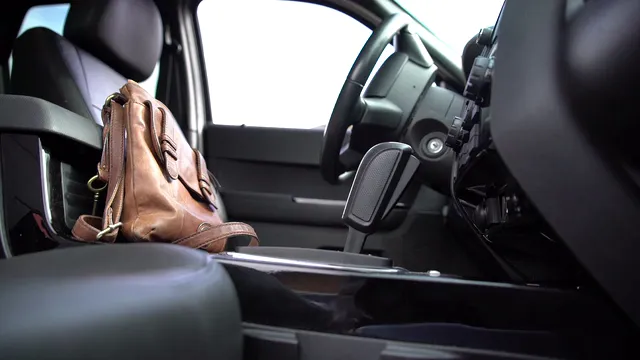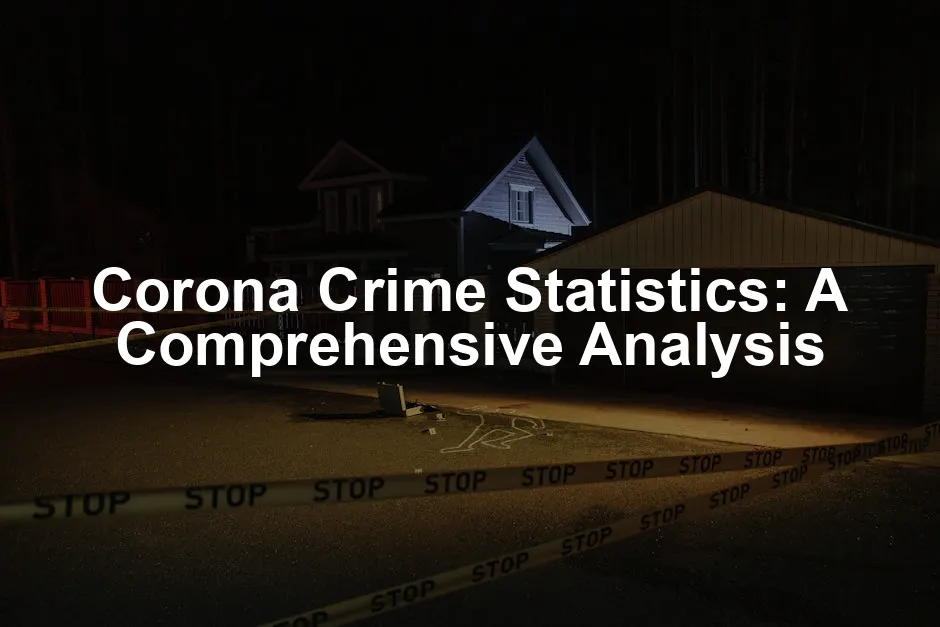Introduction
Crime statistics play a vital role in ensuring community safety. They help residents stay informed and encourage proactive measures to combat crime. In Corona, California, these statistics provide insights into local safety and trends that can impact residents’ daily lives.
Nestled in Riverside County, Corona boasts a population of over 159,000. This city, known for its beautiful parks and vibrant community, faces unique challenges when it comes to crime. While it offers a generally pleasant living environment, understanding its crime rates is essential for residents and prospective movers.
Recent trends reveal a complex picture of crime in Corona. Compared to national averages, some crime rates are higher, sparking concerns among residents. By examining these statistics, we can better understand the safety landscape in Corona and its implications for community well-being.
In this section, we’ll explore the crime statistics in Corona, focusing on recent trends and comparisons to national averages. Buckle up for a data-packed ride through the world of Corona crime!

Understanding Crime Statistics
What Are Crime Statistics?
Crime statistics are numerical data representing incidents of crime within a specific area. They are crucial for urban planning, resource allocation, and public safety measures. These statistics help communities understand crime patterns and identify areas needing attention.
Collecting crime data involves various sources. The FBI compiles information from law enforcement agencies across the U.S. Local police departments report incidents, while community surveys gather resident experiences. This multi-faceted approach ensures comprehensive data that reflects the true nature of crime in any given area.
The importance of these statistics cannot be overstated. They guide policymakers, inform law enforcement strategies, and empower communities to take action against local crime. Understanding crime statistics allows residents to make informed decisions about safety and community involvement, ultimately fostering a safer environment for all.

Types of Crime Statistics
Violent Crime
Violent crime refers to offenses that involve force or threat of force against individuals. Common examples include murder, rape, robbery, and assault. These types of crimes are particularly concerning for communities, as they directly impact personal safety and well-being.
Calculating violent crime rates involves dividing the number of reported incidents by the total population, usually expressed per 1,000 residents. This method allows for a clearer understanding of the scope of violent crime in a specific area. Tracking these rates over time can reveal trends, helping communities assess their safety and the effectiveness of local law enforcement initiatives.
To enhance your safety, consider investing in a Home Security System. This investment can provide peace of mind, allowing you to sleep soundly knowing that you’re protected. After all, feeling safe in your own home is priceless!

Property Crime
Property crime encompasses offenses that involve the theft of property or damage to it. Common examples are burglary, theft, and motor vehicle theft. Understanding property crime statistics is crucial for residents, as these crimes can significantly affect personal belongings and community well-being.
Property crime rates are calculated similarly to violent crime rates. This statistical approach allows for a comparison of property crime incidents across different regions and over time. By analyzing these statistics, communities can identify patterns and implement measures to improve safety and reduce property crime.
Enhance your property security with Motion Sensor Lights. They can deter potential intruders and brighten up your yard at night, giving you that extra layer of safety without breaking the bank!
Together, violent and property crime statistics paint a comprehensive picture of the safety landscape in any area. By understanding these categories, residents can develop a better awareness of their surroundings and take appropriate actions to protect themselves and their property.

Crime Statistics in Corona, CA
Current Crime Rate Overview
When it comes to crime statistics, Corona, CA, presents a curious case. Based on the latest FBI data released in October 2023, the overall crime rate in Corona stands at 27 crimes per 1,000 residents. For context, that’s higher than 75% of California’s cities. So, if you’re thinking of moving here, you might want to keep your eyes peeled!
To break it down further, the chances of becoming a victim of any crime in Corona are approximately 1 in 38. Meanwhile, violent crimes are less frequent, with a rate of 2.21 per 1,000 residents. That’s about 1 in 452 for violent crimes. So while you might want to keep your doors locked, you’re not likely to encounter a violent crime every day.
Comparing Corona’s crime rates to state and national averages paints an interesting picture. The city’s overall crime rate is about 13% higher than the national average. However, when it comes to violent crime, Corona performs better, showing a rate 42% lower than the national average. This contradiction may prompt one to wonder: how can property crime be higher while violent crime is lower?
The property crime rate in Corona is notably concerning. At 24.45 per 1,000 residents, it exceeds the national average significantly. The chances of being a victim of property crime are about 1 in 41. Burglary, theft, and motor vehicle theft are the main contributors, with 645 burglaries, 2,598 thefts, and 659 vehicle thefts reported.
Interestingly, Corona has one of the highest rates of motor vehicle theft in the nation. This statistic might make you rethink where you park your car. To safeguard your vehicle, consider using a Steering Wheel Lock, which can deter thieves and keep your car safe.
While the city has its fair share of crime, many residents still feel relatively safe. A recent survey indicated that 60% of respondents feel pretty safe, although some admit to safety concerns.
In summary, crime statistics in Corona reveal a mixed bag. While violent crime rates are lower than national averages, property crime poses a significant threat. Hence, the question arises: what’s the best way to navigate this complex crime landscape? Understanding these statistics can empower residents to adopt practical safety measures and stay informed about their community. After all, knowledge is power, especially when it comes to keeping oneself safe in Corona!

To gain a deeper understanding of crime trends, check out this comprehensive analysis of safety in Fremont. fremont crime statistics
Violent Crime Statistics in Corona
Breakdown of Violent Crimes
Let’s break down the violent crime statistics in Corona. According to the latest data, the violent crime rate sits at 2.21 per 1,000 residents, translating to about 350 reported incidents. Notably, the categories of violent crimes include murder, rape, robbery, and assault.
In terms of specific incidents, here’s how the numbers stack up:
- Murder: 4 incidents (a rate of 0.03)
- Rape: 37 incidents (0.23 rate)
- Robbery: 105 incidents (0.66 rate)
- Assault: 207 incidents (1.30 rate)
Comparing these numbers to historical data reveals some interesting trends. For instance, in 2022, the murder rate in Corona was notably higher than in 2021, where there were only 1-2 murders reported. However, the overall rate of violent crime has seen fluctuations over the past decade.
In 2020, COVID-19 played a role in crime statistics, with many police departments reporting a decrease in overall crime during the lockdowns. However, domestic violence incidents surged, leaving many communities grappling with the emotional and psychological effects of isolation.
Looking back even further, the trend shows that while Corona has experienced spikes in certain violent crimes, such as assaults and robberies, its murder rate has remained relatively low. In previous years, some areas reported multiple murders annually, which can understandably cause concern among residents.
In conclusion, while the numbers might seem alarming, it’s essential to view them in context. With a lower violent crime rate compared to national figures, residents can take comfort in knowing that violent crime isn’t an everyday occurrence. Nevertheless, staying vigilant and aware of surroundings is always a good practice. It’s a good idea to keep an eye on local trends and community initiatives aimed at reducing crime and enhancing safety.

Property Crime Statistics in Corona
Breakdown of Property Crimes
Now, let’s turn our attention to property crime in Corona. This category of crime encompasses burglary, theft, and motor vehicle theft. As mentioned earlier, the property crime rate in Corona is a staggering 24.45 per 1,000 residents. That’s much higher than the national average, making residents understandably anxious.
Breaking down the specifics:
- Burglary: 645 incidents (4.04 rate)
- Theft: 2,598 incidents (16.28 rate)
- Motor Vehicle Theft: 659 incidents (4.13 rate)
The sheer volume of thefts raises eyebrows. Theft alone accounts for a significant portion of property crimes in Corona. It’s also worth noting that Corona has one of the highest rates of motor vehicle theft in the nation. So, if you have a shiny new car, it might be wise to invest in a good security system or a sturdy Steering Wheel Lock.
Analyzing the trends over the past few years reveals some concerning patterns. Property crime, particularly theft and burglary, has seen an upward trajectory. Community reports indicate that many residents have become more vigilant in reporting suspicious activities.
The implications of these statistics are significant. High property crime rates can lead to a sense of insecurity among residents, prompting many to invest in home security systems or neighborhood watch programs. Local law enforcement has ramped up efforts to curb property crime, with police visibility increasing in several neighborhoods.
For added security, consider installing Security Camera Systems. They can provide invaluable footage and peace of mind, ensuring you know what’s happening around your property at all times.
While crime rates can be disheartening, knowledge is empowering. By understanding the statistics, residents can take proactive steps to safeguard their homes. Engaging with local law enforcement and community safety initiatives can foster a safer environment in Corona.
In conclusion, while property crime poses an ongoing challenge, awareness of crime trends can help residents make informed decisions. With the right precautions and community engagement, Corona can work towards a safer future for its residents.

Crime Trends and Factors Influencing Crime Rates
Year-over-Year Crime Trends
When we look at crime trends in Corona, we see a rollercoaster of statistics that can make anyone’s head spin! Over the last few years, the overall crime rate has experienced notable fluctuations. In 2022, the total crime rate increased by 10.2% compared to the previous year. Property crime, specifically, saw a rise of 7.8%. Meanwhile, violent crime shot up by a jaw-dropping 45.8%. If this sounds alarming, it’s because it is!
Let’s break it down further. The property crime rate in Corona currently stands at approximately 24.45 per 1,000 residents. This figure is significantly higher than the national average, which raises eyebrows. One might wonder why folks are suddenly feeling like they’re living in a crime novel. Could it be the rising cost of living driving individuals to desperate measures? Or perhaps an increase in visibility of local crime through social media has made residents more aware of their surroundings?
On the flip side, the violent crime rate has generally remained lower than the national average. With a rate of 2.21 per 1,000 residents, Corona’s violent incidents are fewer than expected. This means that while property crimes are on the rise, residents can breathe a bit easier when it comes to violent encounters. A closer examination reveals that assaults have increased, but other categories like murder have stayed relatively low.
Comparing these trends to prior years reveals a landscape filled with ups and downs. For instance, in 2020, the COVID-19 pandemic led to a temporary drop in overall crime rates, as many people stayed home and police focused on public health. However, as restrictions eased, crime began to creep back up, resulting in the current statistics.
As we analyze these trends, it’s crucial to consider the broader implications. Increased crime rates can lead to a sense of insecurity within the community, causing residents to feel unsafe in their own neighborhoods. This, in turn, can drive individuals to invest in security measures or even reconsider their living situation.
To sum up, the year-over-year crime trends in Corona paint a picture of a city grappling with rising property crime rates while managing to keep violent crime relatively low. Understanding these trends helps residents make informed decisions about their safety and community involvement, ensuring they remain proactive rather than reactive.

Factors Contributing to Crime in Corona
Understanding the factors contributing to crime in Corona is like piecing together a puzzle with missing pieces. Several socio-economic conditions, community dynamics, and even the impact of the COVID-19 pandemic play significant roles in shaping the crime landscape.
First, let’s talk about socio-economic factors. The cost of living in Corona is approximately 37.83% higher than the national average. This financial strain can lead to desperation in some individuals, pushing them towards criminal activities as a means of survival. It’s a sad reality that when the bills pile up, some might see crime as their only option.
Next up is the law enforcement presence—or lack thereof. With just 1.3 officers per 1,000 residents, Corona’s police presence is below both state and national averages. This can create a perception of vulnerability among residents. If people feel that law enforcement is stretched thin, they may become more vigilant and anxious about their safety. A community where residents feel supported by law enforcement tends to report lower crime rates.
Now, let’s sprinkle in the impact of the COVID-19 pandemic. The lockdowns and restrictions that swept through the nation brought about a unique twist to crime statistics. While many types of crime saw a decline initially, domestic violence incidents surged. Isolation left vulnerable individuals without support systems, leading to an uptick in distressing behaviors. As the world reopened, we saw a rebound in various crimes, particularly property crimes, as people resumed their daily lives.
Community response also plays a vital role. A majority of residents feel moderately safe, with 60% expressing confidence in their neighborhood’s safety. However, a strong community can deter crime. Neighborhood watch programs and active engagement can help residents feel empowered and less likely to fall victim to crime.
In conclusion, the factors influencing crime in Corona are multifaceted. From economic pressures to law enforcement dynamics and the lingering effects of the pandemic, each piece contributes to the overall picture. Understanding these elements allows residents to take a proactive approach to their safety, ensuring they’re not just statistics but a community determined to thrive together.

Neighborhood Safety in Corona
Safest Neighborhoods
When it comes to safety, Corona has some shining stars! Let’s take a look at the neighborhoods with the lowest crime rates. These areas aren’t just known for their picturesque views; they also offer peace of mind to their residents.
- Sycamore Creek: Nestled in the hills, this area boasts well-maintained homes and a tight-knit community. Residents here enjoy serene walks and the occasional deer sighting without worrying about crime.
- Chase Ranch: This family-friendly neighborhood is known for its parks and playgrounds. Community events keep the vibe lively, and crime rates here are notably low.
- Eagle Glen: With stunning views of the mountains, Eagle Glen provides a safe haven. Its reputation for low crime rates makes it a sought-after area for families and retirees alike.
- The Retreat / Temescal: This gated community offers an extra layer of security. Residents appreciate the peaceful environment and strong community bonds, contributing to its safety.
- South Corona: Known for its friendly atmosphere, South Corona has low crime stats. Residents often engage in neighborhood watch programs, enhancing safety further.
So, what makes these neighborhoods safer? A mix of factors contributes to their tranquility. Strong community involvement plays a significant role. When neighbors look out for one another, crime tends to drop. Additionally, well-maintained public spaces and parks promote community pride, discouraging criminal activity.

Another vital aspect is the presence of law enforcement. Areas with visible police patrols often see lower crime rates. In Corona, proactive policing and community policing strategies have made a noticeable difference.
In summary, if you’re looking for safety in Corona, these neighborhoods should be on your radar. With active communities and dedicated law enforcement, they offer a secure environment for families and individuals alike.
Areas of Concern
Not every neighborhood in Corona is a safety haven, though. Certain areas face higher crime rates, raising concerns among residents. Let’s shine a light on these neighborhoods and explore the prevalent issues.
- North Corona: This area has seen an uptick in property crimes. Burglary and theft are particularly common, making residents wary of leaving their homes unattended.
- Downtown Corona: While vibrant, it has its share of challenges. Incidents of vandalism and drug-related crimes have been reported. Local businesses often engage in surveillance measures to deter criminal activity.
- Cresta Verde: This neighborhood has experienced a rise in vehicle thefts. With its proximity to busy roads, opportunistic thieves have targeted unsuspecting residents.
To tackle these concerns, community initiatives are underway. Residents have formed neighborhood watch groups, which actively monitor suspicious activities. These groups foster communication and cooperation with local law enforcement, leading to improved safety.
Additionally, community forums aim to discuss safety concerns and brainstorm solutions. Local authorities have also increased police presence in these neighborhoods, hoping to deter crime through visibility.
Education plays a crucial role too. Residents are encouraged to secure their homes better and report suspicious behavior. Awareness campaigns on crime prevention strategies are popping up, aiming to empower the community.
To further enhance personal safety, consider carrying a Personal Safety Alarm. This compact device can alert others in an emergency, providing you with a sense of security when you’re out and about.
In conclusion, while some areas in Corona present challenges regarding safety, community engagement and proactive measures are paving the way for improvement. By working together, residents can foster a safer environment and reclaim their neighborhoods from crime.

Conclusion
In analyzing crime statistics in Corona, California, a mixed bag emerges. The overall crime rate stands at 27 incidents per 1,000 residents, placing it above 75% of other California cities. While the violent crime rate is relatively low at 2.21 per 1,000, property crime is a different story, with a rate of 24.45 per 1,000 residents. This disparity leaves residents scratching their heads: why do property crimes outweigh violent ones?
The importance of community awareness cannot be overstated. With the chances of becoming a victim of any crime at 1 in 38, residents should stay informed. Proactive measures, such as neighborhood watch programs and increased communication with local law enforcement, can help enhance safety. After all, a vigilant community is a safer community.
Looking ahead, crime statistics in Corona will likely continue to fluctuate. The rise in property crime indicates a pressing need for community engagement. Local law enforcement is working hard to address these issues, but residents must also play their part. Increased awareness, open dialogue, and active participation in safety initiatives can foster a more secure environment.
Moreover, external factors, such as economic conditions and post-pandemic recovery, will shape future crime trends. As the community rebounds from the effects of COVID-19, addressing the socio-economic challenges will be crucial. The connection between economic strain and crime is well-documented, and understanding this link can help the community take targeted actions to improve safety.
In summary, while crime statistics in Corona present challenges, they also offer opportunities for growth and improvement. By emphasizing community awareness and active engagement, residents can work together to create a safer, more connected environment. With knowledge and collaboration, the community can transform its crime landscape for the better.

FAQs
What is the overall crime rate in Corona, CA?
The overall crime rate in Corona is 27 crimes per 1,000 residents. This figure indicates that Corona experiences a higher crime rate than 75% of California cities. With a chance of becoming a victim of any crime at 1 in 38, residents should remain vigilant and proactive about their safety.
How does Corona’s crime rate compare to other cities in California?
Compared to neighboring cities, Corona’s crime rate is notably higher. For instance, cities like Yorba Linda and Chino Hills boast much lower crime rates. While Corona has a violent crime rate 42% lower than the national average, its property crime rate is a significant concern, exceeding the national average by a considerable margin.
What should residents do to stay safe in Corona?
To enhance personal safety, residents should stay informed about local crime trends and participate in community initiatives. Joining neighborhood watch programs, reporting suspicious activities, and maintaining good relationships with law enforcement can all contribute to a safer environment. Additionally, securing homes with alarms and outdoor lighting can deter potential criminals.
How has COVID-19 impacted crime rates in Corona?
The COVID-19 pandemic had mixed effects on crime in Corona. Initially, many types of crime decreased during lockdowns, but property crimes surged as restrictions eased. Domestic violence incidents increased during the pandemic, highlighting the need for community support and resources for vulnerable individuals.
Where can I find more information on crime statistics in my area?
Residents can access crime statistics through local law enforcement websites, the FBI’s Uniform Crime Reporting program, and community safety tools. Websites like NeighborhoodScout and AreaVibes provide detailed insights into crime rates and trends in specific areas, offering valuable resources for residents seeking to stay informed.
Please let us know what you think about our content by leaving a comment down below!
Thank you for reading till here 🙂
All images from Pexels




